An Extended Model for Analyzing the Heat Transfer in the Skin–Microenvironment–Fabric System during Firefighting
Abstract
:1. Introduction
2. Heat Transfer Model of the Skin–Microenvironment–Fabric System
2.1. Heat Transfer between Fabric and Heat Source
2.2. Heat Transfer in the Multi–Layer Fabric System
2.3. Heat Transfer in the Microenvironment
2.4. Heat Transfer in Skin Tissue
2.5. Skin Burn Prediction
2.6. Numerical Solution
3. Results and Discussion
3.1. Model Validation
3.2. Effects of Fabric Periodic Movement on the Heat Transfer and Skin Burns
3.3. Effects of Human Body Movement Speed on the Heat Transfer and Skin Burns
4. Limitations
5. Conclusions
- (1)
- Fabric periodic movement reduced the time to skin burns during human body movement compared to no fabric movement and skin temperature increased as fabric movement amplitude increased.
- (2)
- When the firefighters entered the fireground, the rate of temperature increase in each layer of the skin–microenvironment–fabric system increased with the speed of human body movement. The skin burn injury began with rapid movement.
- (3)
- Human body movement speed along the same movement path has a significant effect on skin burn. The current model reduces the time to 2nd degree burn by 33.3–35.2% under medium movement speed.
- (4)
- At low movement speeds, the time to skin burns was negatively correlated with fabric movement amplitude. With an increase in fabric movement amplitude, the time to 2nd degree burn was reduced by 7.9%. When the fabric movement amplitude was 2.5 mm at medium and high movement speeds, the negative effect of fabric movement amplitude on skin burn was eliminated. Reduced time to 2nd degree burn was by 12.9–29.8% when compared to 2 mm fabric movement amplitude.
Author Contributions
Funding
Data Availability Statement
Conflicts of Interest
References
- Song, G.; Paskaluk, S.; Sati, R.; Crown, E.M.; Doug Dale, J.; Ackerman, M. Thermal protective performance of protective clothing used for low radiant heat protection. Tex. Res. J. 2011, 81, 311–323. [Google Scholar] [CrossRef]
- Lee, Y.M.; Barker, R.L. Thermal protective performance of heat-resistant fabrics in various high intensity heat exposures. Tex. Res. J. 1987, 57, 123–132. [Google Scholar]
- Song, G. Clothing air gap layers and thermal protective performance in single layer garment. J. Ind. Text. 2007, 36, 193–205. [Google Scholar] [CrossRef]
- Torvi, D.A.; Dale, J.D.; Faulkner, B. Influence of air gaps on bench-top test results of flame resistant fabrics. J. Fire Prot. Eng. 1999, 10, 1–12. [Google Scholar] [CrossRef]
- Fu, M.; Weng, W.; Yuan, H. Effects of multiple air gaps on the thermal performance of firefighter protective clothing under low-level heat exposure. Tex. Res. J. 2014, 84, 968–978. [Google Scholar] [CrossRef]
- Barker, R.L.; Guerth-Schacher, C.; Grimes, R.V.; Hamouda, H. Effects of moisture on the thermal protective performance of firefighter protective clothing in Low-level radiant heat exposures. Tex. Res. J. 2006, 76, 27–31. [Google Scholar] [CrossRef] [Green Version]
- Fu, M.; Weng, W.; Yuan, H. Quantitative assessment of the relationship between radiant heat exposure and protective performance of multilayer thermal protective clothing during dry and wet conditions. J. Hazard. Mater. 2014, 276, 383–392. [Google Scholar] [CrossRef]
- Su, Y.; Li, J.; Song, G. The effect of moisture content within multilayer protective clothing on protection from radiation and steam. Int. J. Occup. Saf. Ergon. 2018, 24, 190–199. [Google Scholar] [CrossRef]
- Xin, L.; Li, X.; Li, J. A new approach to evaluate the effect of body motion on heat transfer of thermal protective clothing during flash fire exposure. Fibers Polym. 2014, 15, 2225–2231. [Google Scholar] [CrossRef]
- Torvi, D.A.; Dale, J.D. Heat transfer in thin fibrous materials under high heat flux. Fire Technol. 1999, 35, 210–231. [Google Scholar] [CrossRef]
- Su, Y.; He, J.; Li, J. Modeling the transmitted and stored energy in multilayer protective clothing under low-level radiant exposure. Appl. Therm. Eng. 2016, 93, 1295–1303. [Google Scholar] [CrossRef]
- Phelps, H.; Sidhu, H. A mathematical model for heat transfer in fire fighting suits containing phase change materials. Fire Saf. J. 2015, 74, 43–47. [Google Scholar] [CrossRef]
- Amiri Delouel, A.; Emamian, A.; Sajjadi, H.; Atashafrooz, M.; Li, Y.; Wang, L.; Jing, D.; Xie, G. A comprehensive review on multi-dimensional heat conduction of multi-Layer and composite structures: Analytical solutions. J. Therm. Sci. 2021, 30, 1875–1907. [Google Scholar] [CrossRef]
- Su, Y.; He, J.; Li, J. A model of heat transfer in firefighting protective clothing during compression after radiant heat exposure. J. Ind. Text. 2018, 47, 2128–2152. [Google Scholar] [CrossRef]
- Su, Y.; He, J.; Li, J. Numerical simulation of heat transfer in protective clothing with various heat exposure distances. J. Text. Inst. 2017, 108, 1412–1420. [Google Scholar] [CrossRef]
- Ghazy, A. On the protective performance of firefighters’ garments: Air gaps between fabric layers. Fire Technol. 2019, 56, 821–836. [Google Scholar] [CrossRef]
- Ghazy, A.; Bergstrom, D.J. Numerical simulation of heat transfer in firefighters’ protective clothing with multiple air gaps during flash fire exposure. Numer. Heat Transf. 2012, 61, 569–593. [Google Scholar] [CrossRef]
- Ghazy, A. Numerical study of the air gap between fire-protective clothing and the skin. J. Ind. Text. 2014, 44, 257–274. [Google Scholar] [CrossRef]
- Udayraj.; Talukdar, P.; Das, A.; Alagirusamy, R. Numerical investigation of the effect of air gap orientations and heterogeneous air gap in thermal protective clothing on skin burn. Int. J. Therm. Sci. 2017, 121, 313–321. [Google Scholar] [CrossRef]
- Deng, M.; Psikuta, A.; Wang, Y.; Annaheim, S.; Rossi, R.M. Numerical investigation of the effects of heterogeneous air gaps during high heat exposure for application in firefighter clothing. Int. J. Heat Mass Transf. 2021, 181, 121813. [Google Scholar] [CrossRef]
- Deng, M.; Wang, Y.; Li, P. Effect of air gaps characteristics on thermal protective performance of firefighters’ clothing: A review. Int. J. Cloth. Sci. Technol. 2018, 30, 246–267. [Google Scholar] [CrossRef]
- Ghazy, A.; Bergstrom, D.J. Numerical simulation of the influence of fabric’s motion on protective clothing performance during flash fire exposure. Heat Mass Transf. 2013, 49, 775–788. [Google Scholar] [CrossRef]
- Ghazy, A. On the performance of firefighting suits under different patterns of firefighter’s movement: Radiation heat transfer between layers of the suit. Fire Technol. 2022, 58, 2055–2076. [Google Scholar] [CrossRef]
- Ghazy, A. Evaluating the protective performance of municipal firefighting suits during firefighter’s motion under fire exposure. Fire Technol. 2021, 57, 1827–1846. [Google Scholar] [CrossRef]
- Udayraj; Talukdar, P.; Das, A.; Alagirusamy, R. Numerical modeling of heat transfer and fluid motion in air gap between clothing and human body: Effect of air gap orientation and body movement. Int. J. Heat Mass Transf. 2017, 108, 271–291. [Google Scholar] [CrossRef]
- Łapka, P.; Furmański, P. Modeling and analysis of the influence of the protective garment movement on the skin temperature and burn degree. Fire Saf. J. 2019, 111, 102916. [Google Scholar] [CrossRef]
- Incropera, F.P. Fundamentals of Heat and Mass Transfer; Wiley: New York, NY, USA, 2011. [Google Scholar]
- Sajjadi, H.; Amiri Delouel, A.; Mohebbi, R.; Izadi, M.; Succi, S. Natural convection heat transfer in a porous cavity with sinusoidal temperature distribution using cu/water nanofluid: Double MRT Lattice Boltzmann method. Commun. Comput. Phys. 2021, 29, 292–318. [Google Scholar] [CrossRef]
- Su, Y.; He, J.; Li, J. An improved model to analyze radiative heat transfer in flame-resistant fabrics exposed to low-level radiation. Tex. Res. J. 2016, 87, 1953–1967. [Google Scholar] [CrossRef]
- Wang, F.; Gao, C. Protective Clothing. In Modeling Thermal Skin Burning in Protective Clothing; Ghazy, A., Ed.; Woodhead Publishing: Sawston, UK, 2014; pp. 435–454. [Google Scholar]
- Pennes, H.H. Analysis of tissue and arterial blood temperatures in the resting human forearm. J. Appl. Physiol. 1948, 1, 93–122. [Google Scholar] [CrossRef]
- Morel, A.; Bedek, G.; Salauen, F.; Dupont, D. A review of heat transfer phenomena and the impact of moisture on firefighters’ clothing and protection. Ergonomics 2014, 57, 1078–1089. [Google Scholar] [CrossRef]
- Henriques, F.C. Studies of thermal injury; the predictability and the significance of thermally induced rate processes leading to irreversible epidermal injury. Arch. Pathol. 1947, 43, 489–502. [Google Scholar]
- Zhai, L.; Li, J. Prediction methods of skin burn for performance evaluation of thermal protective clothing. Burns 2015, 41, 1385–1396. [Google Scholar] [CrossRef] [PubMed]
- Ghazy, A. Influence of thermal shrinkage on protective clothing performance during fire exposure: Numerical investigation. Mech. Eng. Res. 2014, 4, 1. [Google Scholar] [CrossRef]
- Lu, Y.; Zhai, L.; Li, X.; Wang, M.; Li, J.; Wang, Y. Analyzing thermal shrinkage of fire-protective clothing exposed to flash fire. Fire Technol. 2015, 51, 195–211. [Google Scholar]
- Wakatsuki, K.; Seita, R.; Watanabe, N.; Muramoto, S.; Kobayashi, Y.; Morikawa, H. Correction to: Characterization of air gaps and their impact on the thermal insulation performance of multi-layer firefighter clothing. Fire Technol. 2022, 58, 1863–1887. [Google Scholar] [CrossRef]
- Wang, S.; Wang, X.; Wang, Y. Effects of clothing ease and body postures on the air gap and clothing coverage. Int. J. Cloth. Sci. Technol. 2019, 31, 578–594. [Google Scholar] [CrossRef]
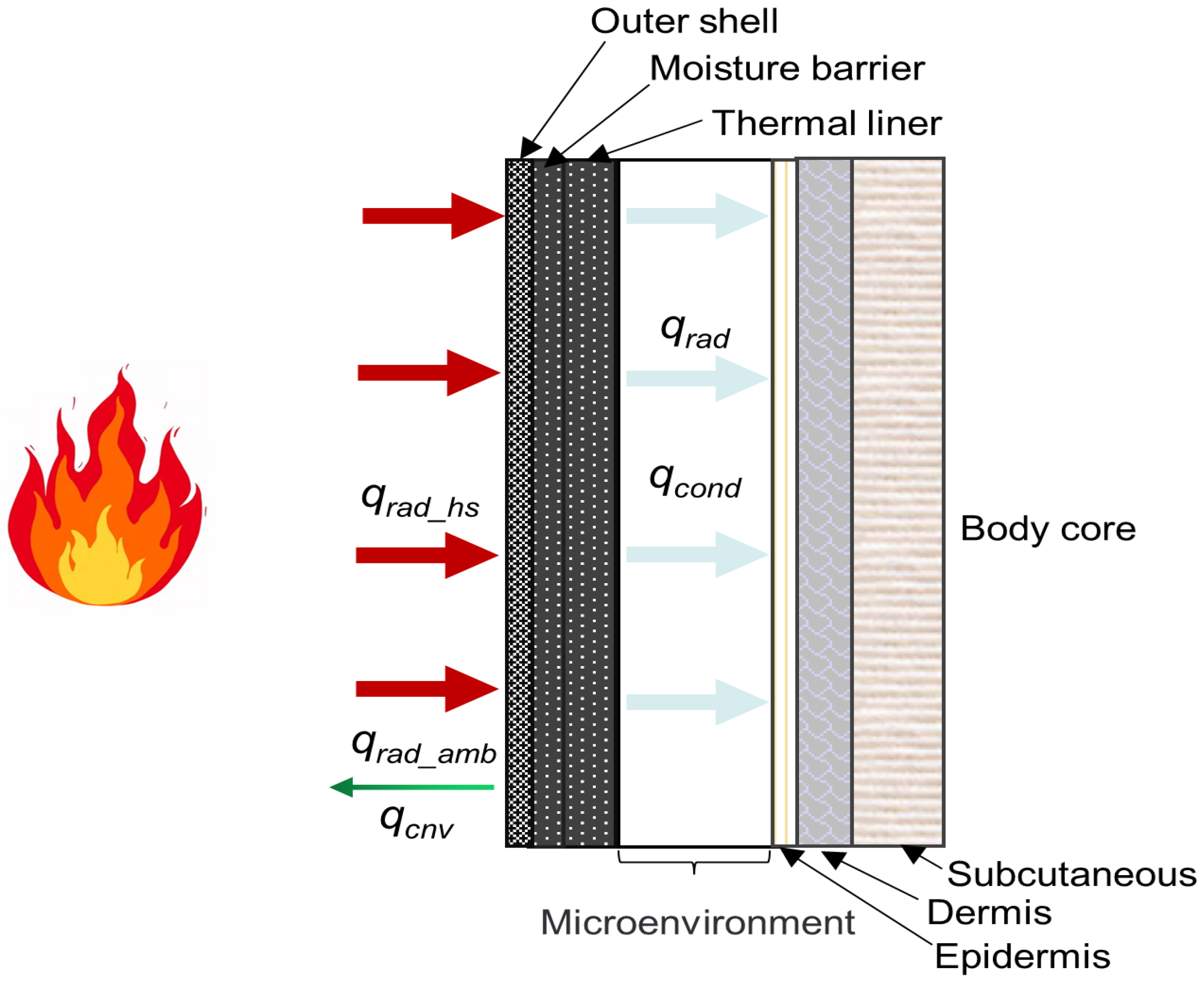

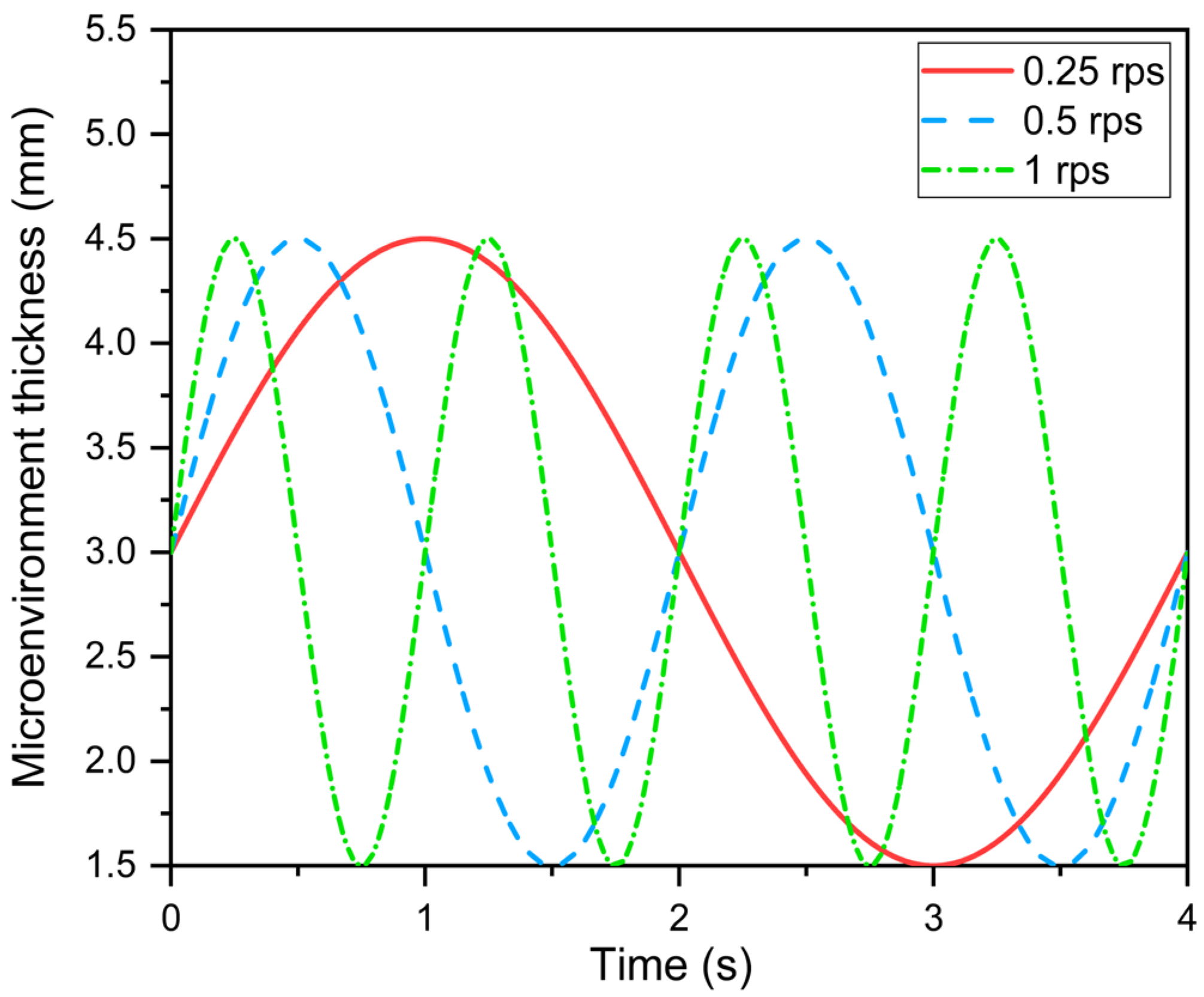


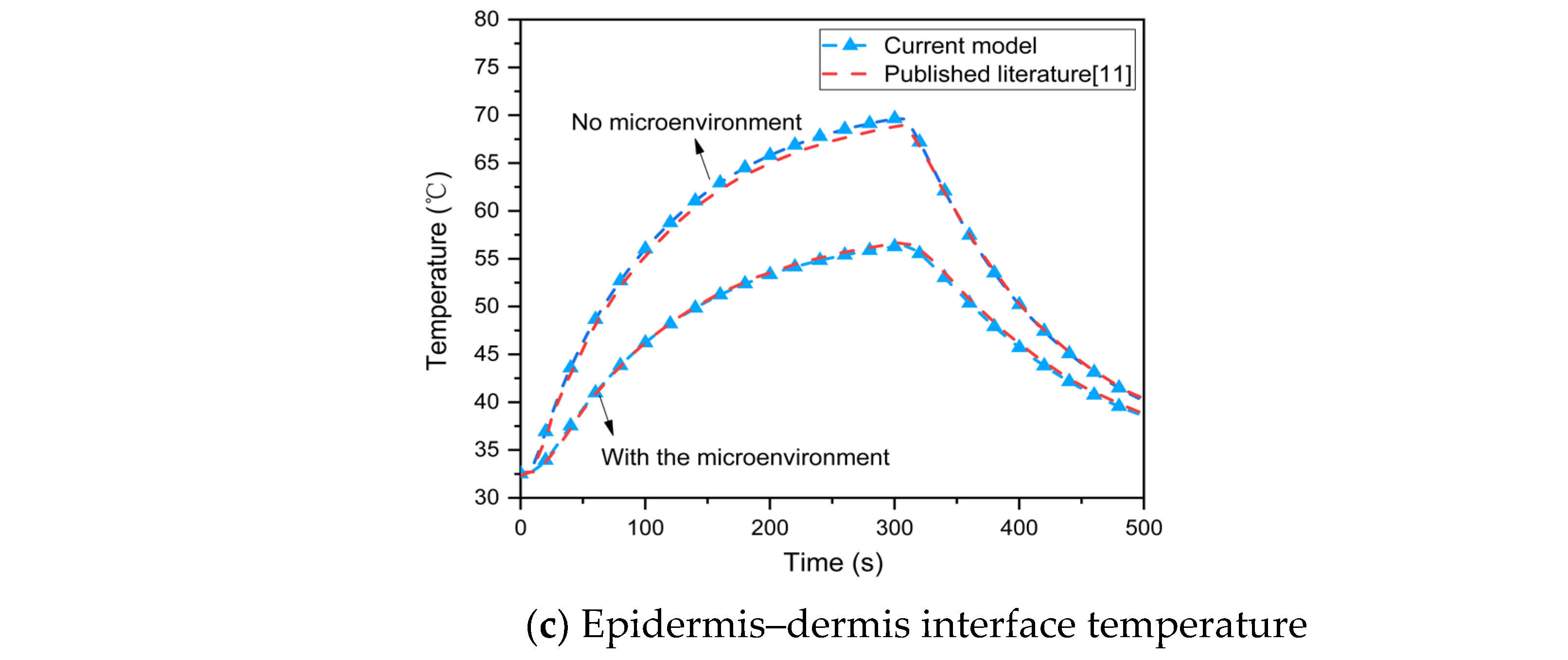
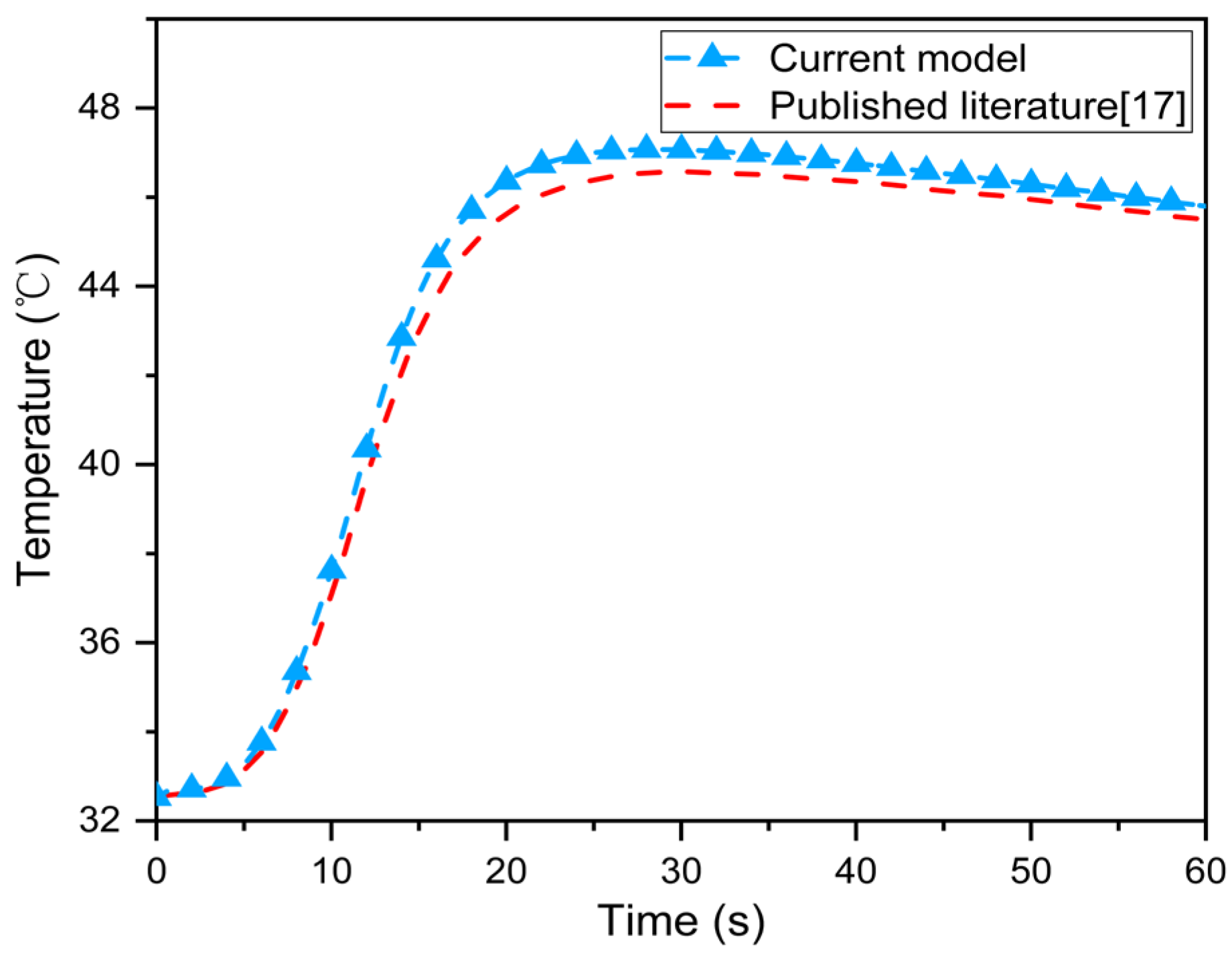

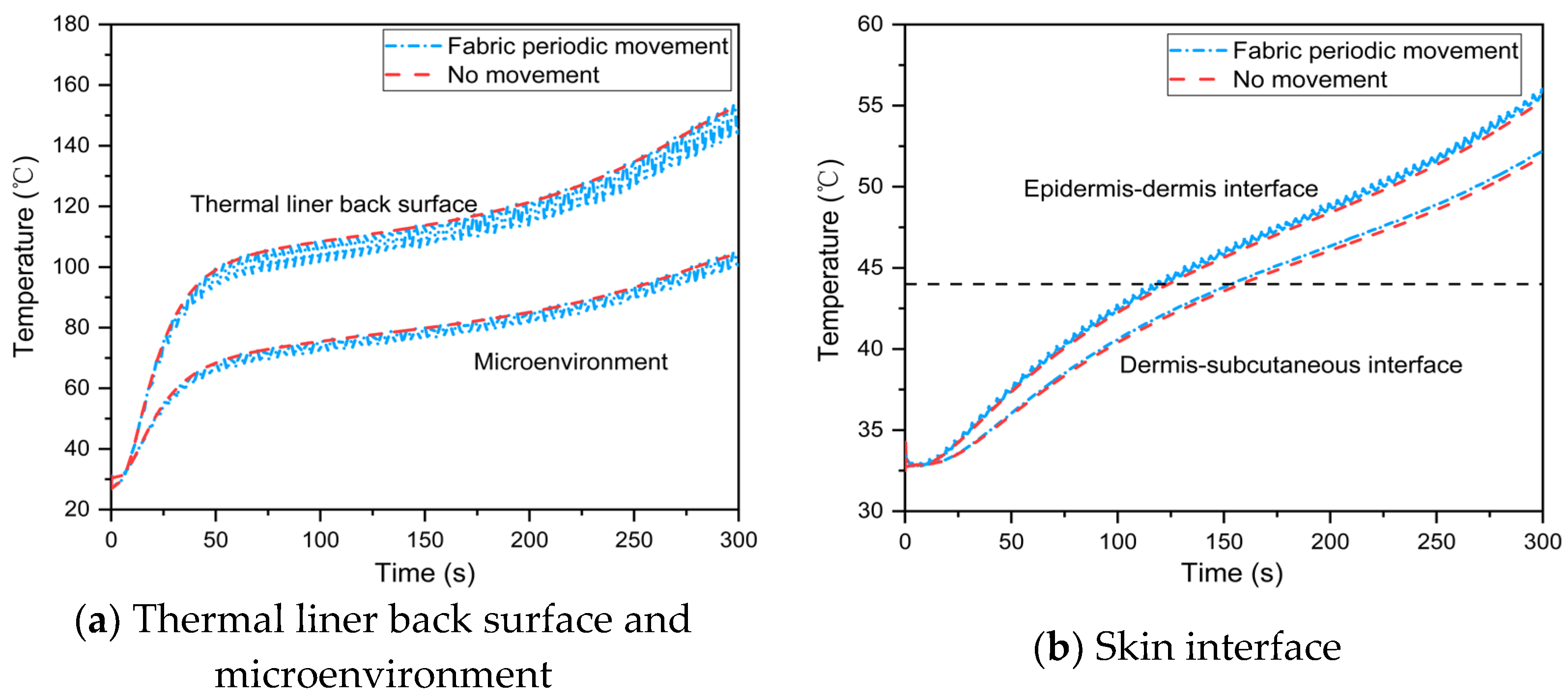
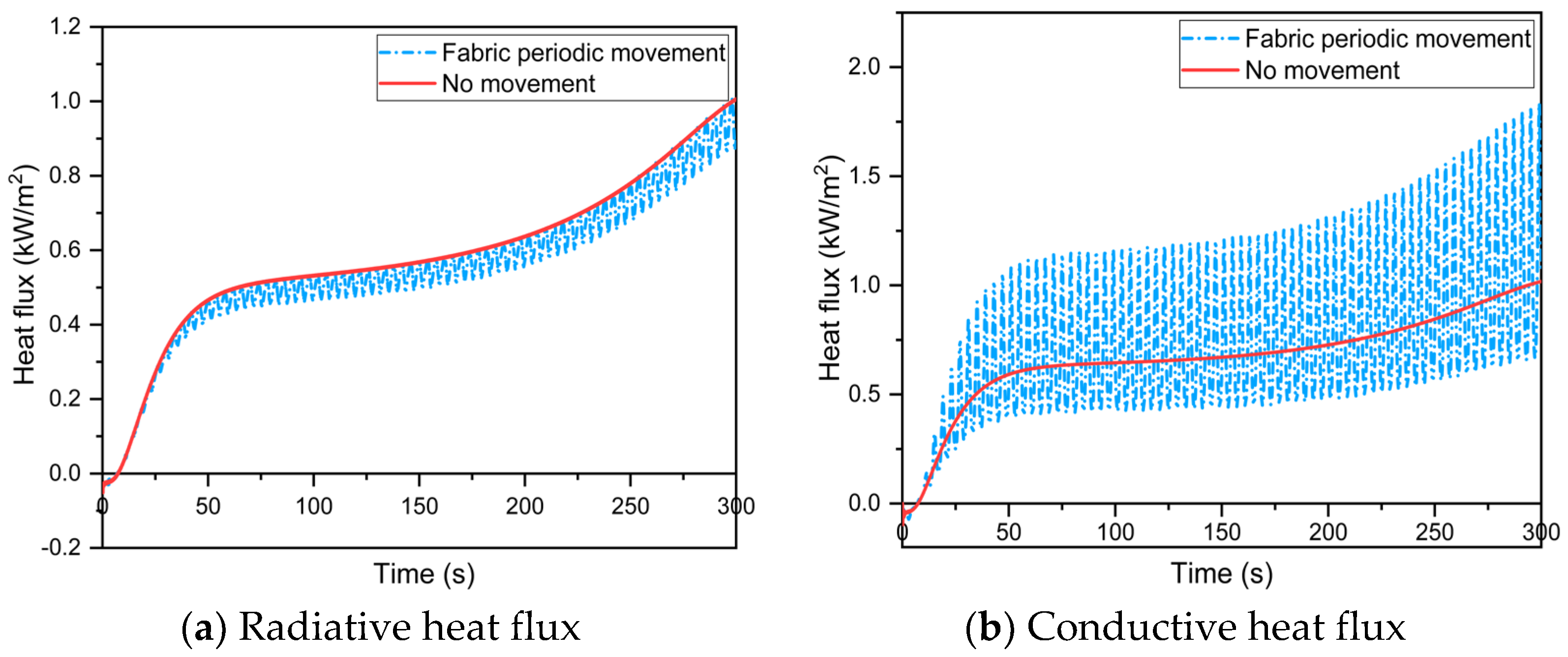


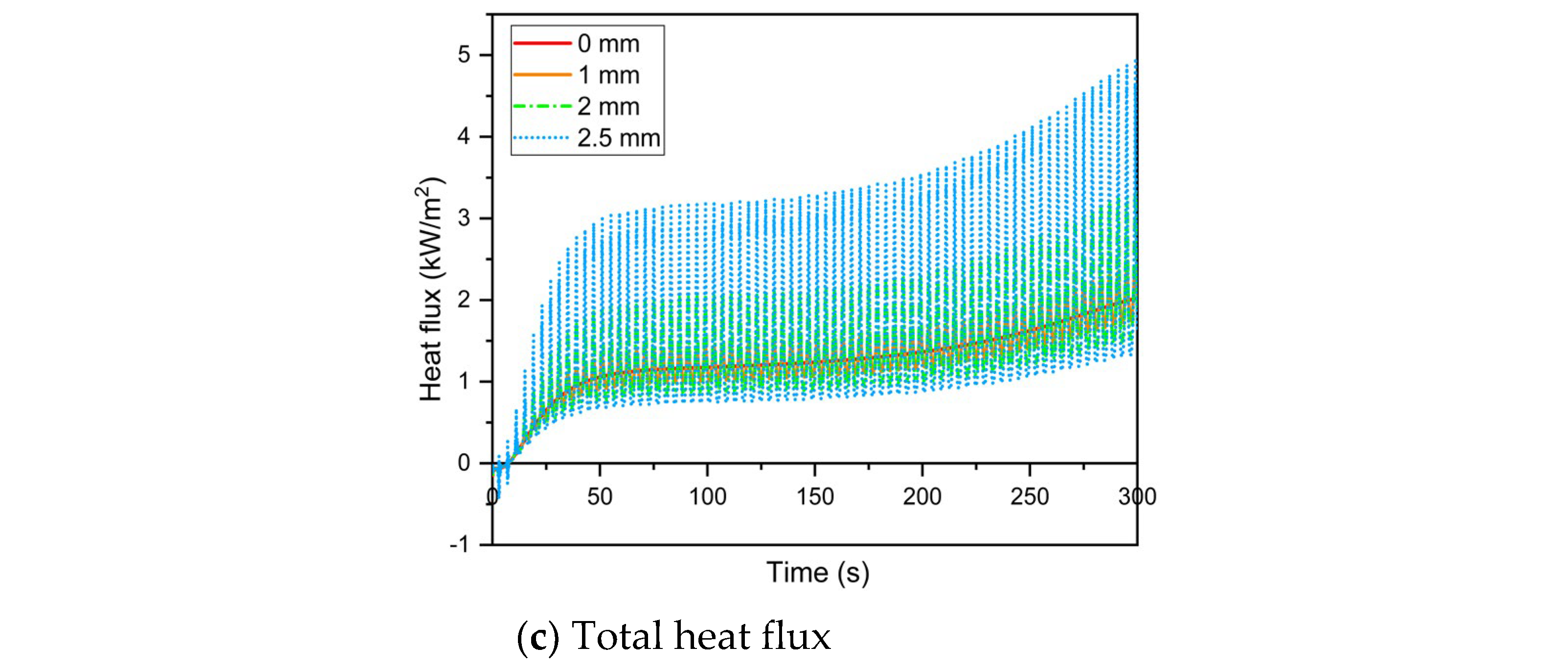
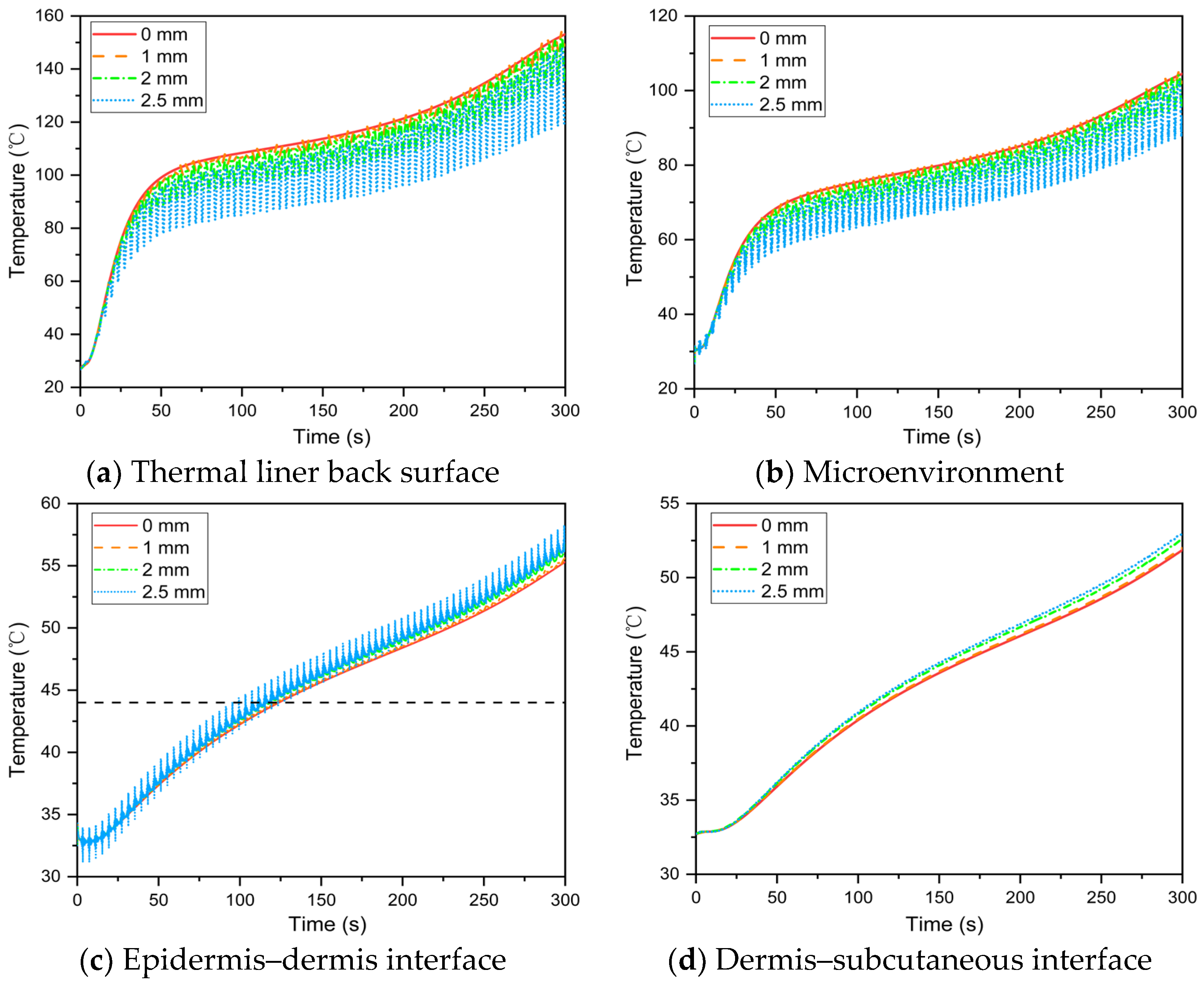
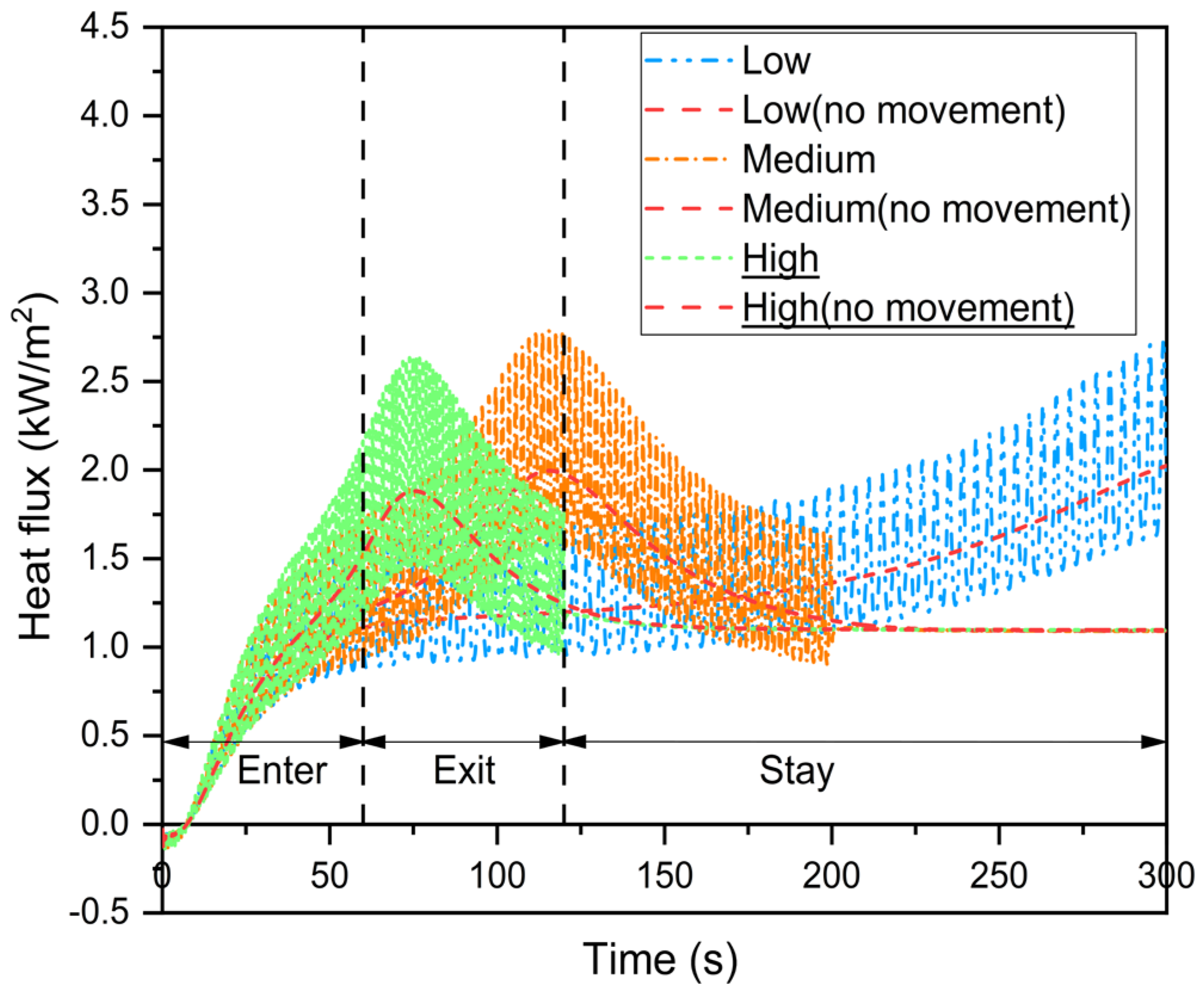
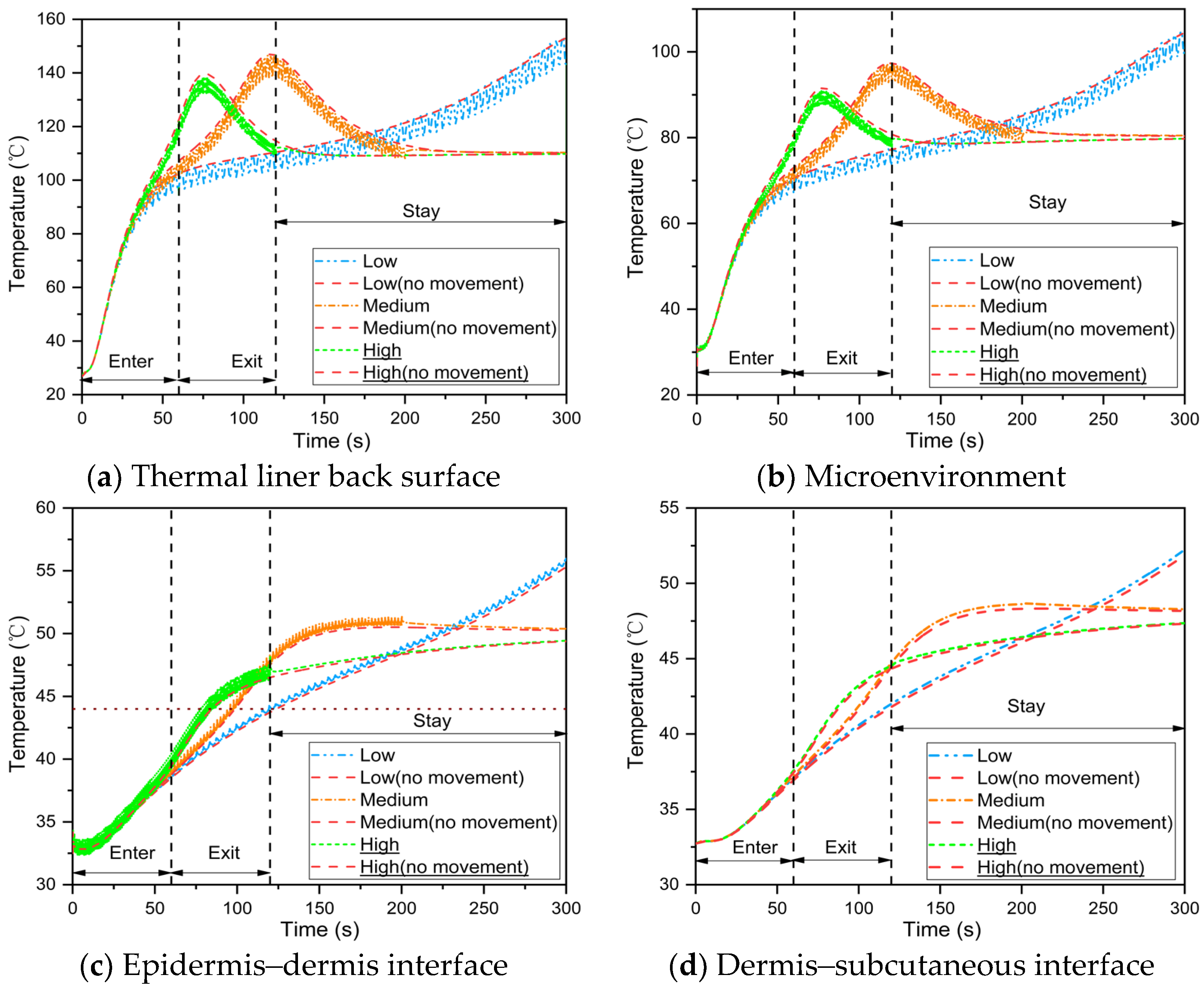
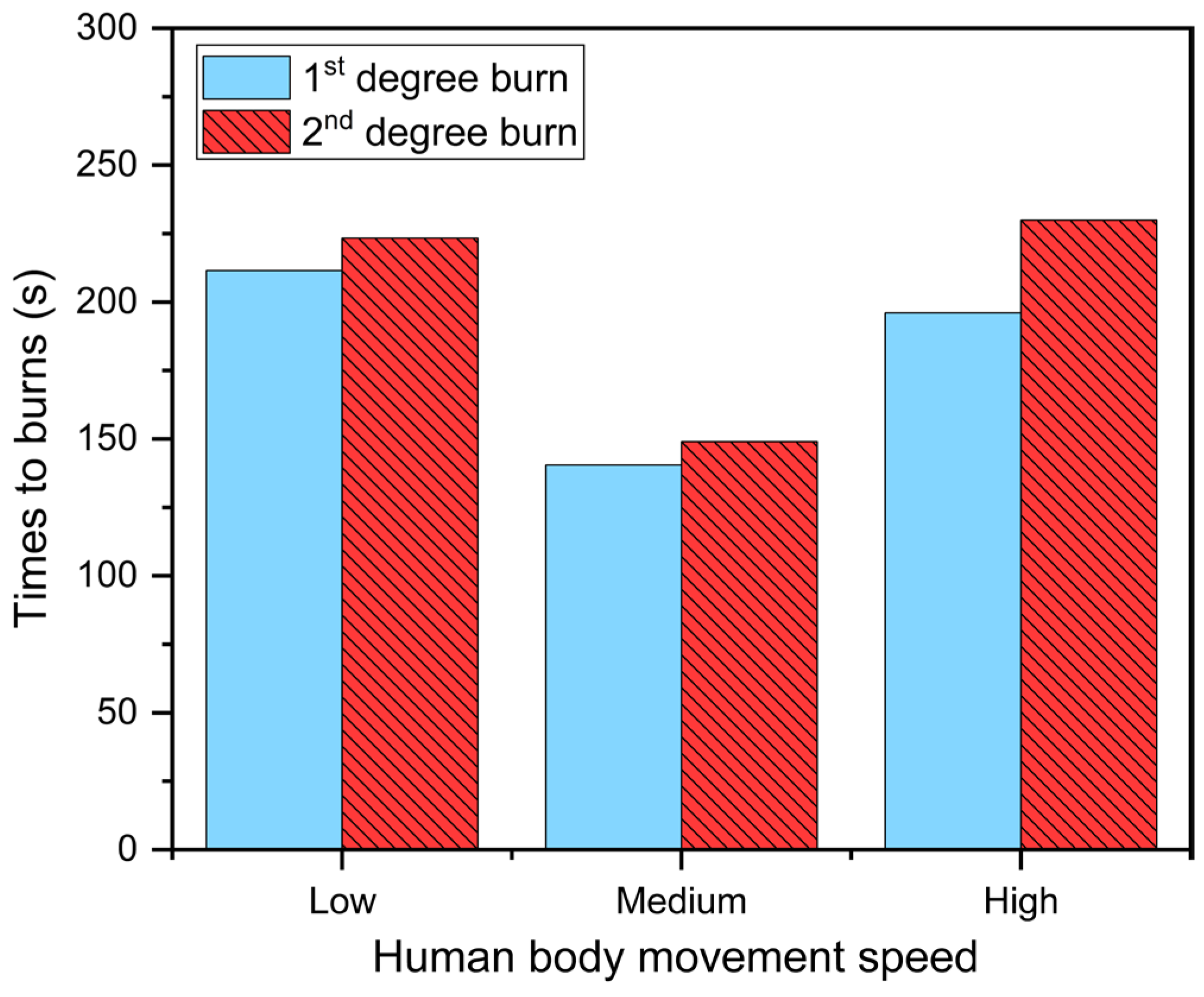

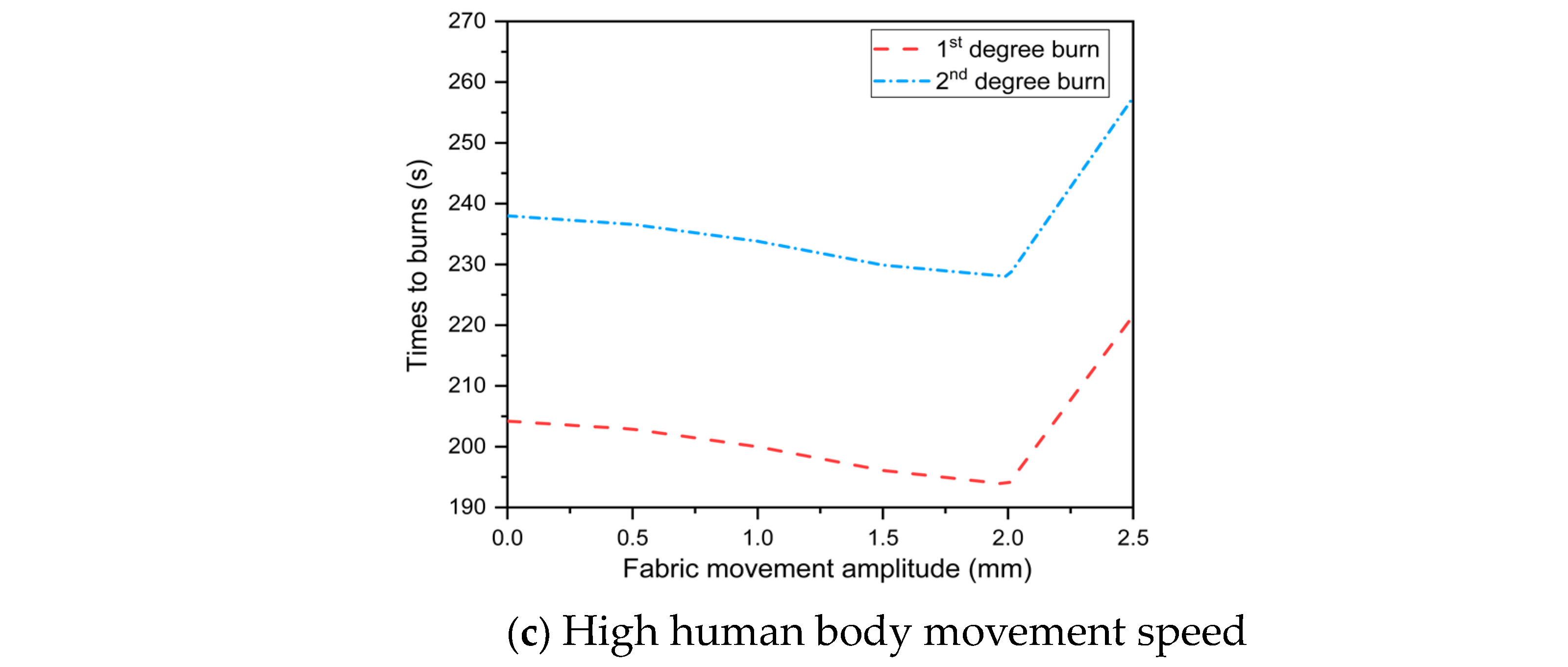
| Skin | Temperature (°C) | (s−1) | ∆E/R (K) |
|---|---|---|---|
| Epidermis–dermis interface | 44 ≤ T ≤ 50 | 2.185 × 10124 | 93,534.9 |
| T > 50 | 1.823 × 1051 | 39,109.8 | |
| Dermis–subcutaneous interface | 44 ≤ T ≤ 50 | 4.32 × 1064 | 50,000 |
| T > 50 | 9.39 × 10104 | 80,000 |
| Time to 2nd Degree Burn (s) | Time to 3rd Degree Burn (s) | |||
|---|---|---|---|---|
| Microenvironment | Stationary | Dynamic | Stationary | Dynamic |
| Published literatures [17,22] | 5.3 | 5.3 | 26.6 | 25.7 |
| Current model | 4.68 | 4.58 | 22.1 | 21.34 |
| Relative error | 11.7% | 13.6% | 16.9% | 17% |
Disclaimer/Publisher’s Note: The statements, opinions and data contained in all publications are solely those of the individual author(s) and contributor(s) and not of MDPI and/or the editor(s). MDPI and/or the editor(s) disclaim responsibility for any injury to people or property resulting from any ideas, methods, instructions or products referred to in the content. |
© 2023 by the authors. Licensee MDPI, Basel, Switzerland. This article is an open access article distributed under the terms and conditions of the Creative Commons Attribution (CC BY) license (https://creativecommons.org/licenses/by/4.0/).
Share and Cite
Lei, Y.; Wang, F.; Yang, J. An Extended Model for Analyzing the Heat Transfer in the Skin–Microenvironment–Fabric System during Firefighting. Materials 2023, 16, 487. https://doi.org/10.3390/ma16020487
Lei Y, Wang F, Yang J. An Extended Model for Analyzing the Heat Transfer in the Skin–Microenvironment–Fabric System during Firefighting. Materials. 2023; 16(2):487. https://doi.org/10.3390/ma16020487
Chicago/Turabian StyleLei, Ying, Faming Wang, and Jie Yang. 2023. "An Extended Model for Analyzing the Heat Transfer in the Skin–Microenvironment–Fabric System during Firefighting" Materials 16, no. 2: 487. https://doi.org/10.3390/ma16020487







